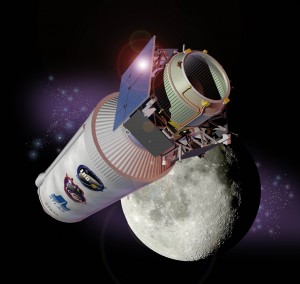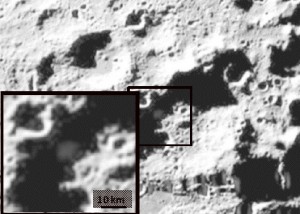Who found the water on the Moon?

At just over two tonnes, the second stage of an Atlas V rocket, makes for an unusual ‘kinetic probe’. Nonetheless on October 9, 2009 NASA deliberately impacted a spent Centaur rocket into the lunar south polar crater Cabeus. The target area was a permanently shadowed region within this crater. The impact, not surprisingly, ejected a spectacular plume of debris, dust and vapour.
Science experiment, observe the system, perturb it, and measure what happens
The US scientists had thrown a heavy object at the Moon. They then threw all the instruments possible to monitor the impact. The prize was a decades-long search to directly find water on the Moon.
The impact would have been majestic to watch. Picture those slow motion images of Apollo astronauts on the Moon. Hold that thought and then imagine the impact. An observer could marvel at the slow motion, low gravity, return of the dust and debris cloud to the Moon’s surface. If you could see in the infra-red, the impact flash lasts for 10 seconds. There is a cloud of debris, dust, and vapour rising. At eight seconds the the ejecta cloud is 4.5km in diameter, in the ultra-violet spectrum, the plume is 10km in diameter. At 20 seconds after impact the ejecta cloud was is at its maximum diameter of 8.5km and the plume has reduced to little less than 10km.
The observer would be watching a science experiment on a grand scale.
The observer in this experiment was neither you nor I, it was a trailing “shepherding spacecraft”. The Centaur had propelled NASA’s Lunar Reconnaissance Orbiter and Lunar Crater Observation and Sensing Satellite to the Moon. Shortly after launch the Lunar Reconnaissance Orbiter had separated to go on its own mission. Once in lunar orbit the Centaur had vented its remaining fuel. Control was then assumed, for the next four months, by the Lunar Crater Observation and Sensing Satellite as the shepherding satellite. During this next period the shepherding satellite maneuvered the Centaur to allow the Sun to bake-out residual water and volatiles. This was to ensure that no contaminant chemicals were passengers to the lunar impact site. The Centaur’s fuel was a volatile combination of liquid hydrogen and liquid oxygen, both chemicals that were to be scanned for in the impact cloud. The Lunar Crater Observation and Sensing Satellite also calibrated its instruments, then targeted the Centaur to impact with the Moon. Four months of meticulous preparation.

The Lunar Crater Observation and Sensing Satellite carried nine instruments, including cameras, spectrometers and a radiometer. The spectrometers measured the reflected light at different wavelengths. These enabled the identification of the chemicals present in the ejected cloud.
Near-infrared absorbance attributeble to water vapour and ice, and ultraviolet emissions attributable to hydroxyl radicals (OH-) support the presence of water in the debris. The researchers determined from these observations that there was over 5%, by mass, of water ice in the lunar regolith of the impact site. Certainly this is small by terrestrial soil standards, but more substantial than most earlier estimates.
Over a year after the impact, in the October 22, 2010 issue of the journal Science, the results of this experiment were delivered to the world’s attention. This certainly marked a defining moment for lunar scientists, directly confirming the availability of water on the moon. It was however neither the first nor last word on this.

Early attempts
Since the first lunar sample were carried back to earth by Apollo astronauts in the late 1960s, scientists have operated under the presumption that the moon was entirely dry. In total 382kg of lunar material was bought to Earth by the Apollo missions astronauts and a further 0.32kg by the unmanned USSR Lunar missions. New analyses of these rocks with improved analytical techniques have made it possible to perform highly sensitive isotopic measurements on very small lunar grains. These analyses are revealing water in Apollo samples that were once thought to be dry.
Well before these new studies, scientists had been puzzling about why more water was not seen on the moon. It was thought that volatile materials, such as water, could be accumulating at the moon’s permanently shaded polar regions. Here they could be trapped for geological periods of time without significant loss. The in 1998, the orbiting Lunar Prospector spacecraft measured the the abundance of elements on the moon’s surface using neutron spectroscopy. This provided compelling evidence for enhanced hydrogen concentrations, and by inference water, at both of the lunar poles.
In 1999 the Cassini spacecraft flew by the moon on its way to Saturn. It turned its Visual and Infrared Mapping Spectrometer to the moon. By measuring the surface reflectance of light from the moon scientists found absorption attributed to hydroxyl and water on the sunlit surface of the moon. These results were not published until 10 years later, in October 2009. The reason was renewed interest in water on the moon.
On October 22, 2008 Chandrayaan-1 was launched on a lunar mission by the Indian Space Research Organisation. One of its major scientific missions was to look for water on the moon. It had three different instruments ready to make 2008-10 an interesting period for lunar water exploration.
Chandrayaan-1, India’s lunar water finder
The Chandrayaan-1 story is told in detail elsewhere. Here I intend to showcase the marvelous outcome of Chandrayaan-1’s water finding experiments. Perhaps the most exciting of all these was one of the simplest. This was the CHandra’s Altitudinal Composition Explorer (CHACE) on board the Moon Impact Probe.
On November 14 2008 (the birthday of the late Pandit Jawaharlal Nehru, India’s 1st Prime Minister) the Moon Impact Probe became the first Indian built object to reach the surface of the Moon. The probe was a 34kg box-shaped object containing a video image system, radar altimeter, and The CHACE mass spectrometer.
Symbolically the Indian tricolour was painted on three sides of the Moon Impact Probe. This enables India to also lay claim to having the “Indian tricolour placed on the Moon”. Needless to say that “placing” in this case was a hard landing in the Moon’s south polar region near the Shackleton crater, flying over the Malapert mountain en route.
The CHACE mass spectrometer took 650 spectra of the tenuous lunar atmosphere during its 1487 second, 98km, plunge to the lunar surface. Tenuous is right the atmosphere even on the sunlit side is only 7/10,000,000,000th of the Earth’s atmosphere.
The mass spectrometer was tuned to look find water and direct evidence of water it did find. The team leader of the experiment, Dr S M Ahmed, remembers, “We all were jumping when we saw water was literally pouring out of our instrument
 Follow
Follow
The human quest to heavenly bodies has culminated in Neil Armstrong stepping on the Moon. The same urge to know more intrigued every human including a developing country like India. We were some 3-4 hand picked enthusiasts (with ZERO experience in space borne instrumentation) to work on the development of the state-of-the-art instrument to sample the lunar ambiance during the descent of Moon Impact Probe. The feeling of seeing the end product to on the MOON was so compelling that we always used to walk (run) one extra mile to make it to the goal.
When we saw signatures of WATER (the first among the human race to do so); our team’s senior scientist in his 59th year was jumping like a small kid. Today, I know, why he was doing it. As I write this note here; I know that the credit of finding water on the Moon is not in our kitty; but when ever I look at the Moon deep in my heart what I feel is “in the court of LORD, it was my team which had seen Peak#18 Literally pouring out of the instrument”.
S.M.Ahmed, Team leader, CHACE payload
Dr Ahmed I thank you for your comment. I agree the quest to explore the Moon, Mars, the rest of the Solar System to the other galaxies is one that generates much human curiosity and endeavor. I can appreciate your teams excitement at the results of your CHACE experiment, in themselves a great achievement.
The question of primacy, who discovered something first, is also not always the most important one regarding scientific achievement. As Isaac Newton said in a letter (February 5, 1675) to Robert Hooke, “If I have seen further it is by standing on the shoulders of giants.” Finding the water on the Moon was an achievement that stood on the shoulders of many. At the same time every scientist hopes that at some stage during their careers that they too can ‘jump around like a small kid’ with the joy that they have found something that no one else in the world has ever seen!
I wonder what Chandrayaan-2 will discover?